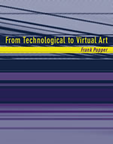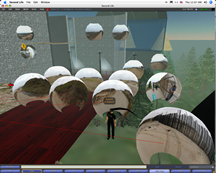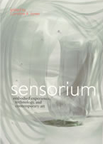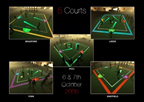Jan 15, 2007
Call for Articles for: Encyclopedia of Artificial Intelligence
Via Neurodudes
From the call for articles
Editors: Juan R. Rabuñal, Julián Dorado & Alejandro Pazos
Nature has always been a source of inspiration for science problem solving. Areas such as Pharmacy, Physics or Aeronautics use biological concepts to reach beyond their current limits.
As far as Computing Science and - more specifically, Artificial Intelligence (AI) - is concerned, the use of biological concepts is highly reliable for achieving good results. At the early stages of AI (1950s), Artificial Neural Networks (ANN) - quite successful as classification and pattern recognition systems - were developed by using the structure of the nervous system as a basis. After these systems, biology has inspired the development of other techniques - among which the evolutionary systems are the most promising ones when dealing with new problems that use a vast amount of data - such as Biomedical Computing or weather forecasting.
Both the techniques based in cell or natural organisms performance, as well as those based on evolutionary theories, have a wide success record when applied to real problems. These types of techniques currently represent a very active area of research, as not only a high number of companies use them, but also many related high level scientific congresses are being held annually on these techniques.
Coverage
To meet this need, currently we are in the process of editing the "Encyclopedia of Artificial Intelligence " that will provide comprehensive coverage and definitions of the most important issues, concepts, trends and technologies in Artificial Intelligence. This important new publication will be distributed worldwide among academic and professional institutions and will be instrumental in providing researchers, scholars, students and professionals with access to the latest knowledge related to Artificial Intelligence techniques.
To ensure that this publication has the most current and relevant coverage of all topics related to Artificial Intelligence, we are asking sholars well-known for their particular area of research, to contribute short articles of 1,500-3,500 words on any of the following topics.
22:45 Posted in AI & robotics | Permalink | Comments (0) | Tags: artificial intelligence
The University of Washington Neural Systems Lab have created a humanoid robot you can control with your thoughts.
![]() Via Mind Hacks
Via Mind Hacks





 Researchers at the University of Washington Neural Systems Lab have created a humanoid robot you can control with your thoughts via a EEG-based non-invasive brain-computer interface.
Researchers at the University of Washington Neural Systems Lab have created a humanoid robot you can control with your thoughts via a EEG-based non-invasive brain-computer interface.
Link to Neural Systems Lab robot info page



20:52 Posted in Brain-computer interface | Permalink | Comments (0) | Tags: brain-computer interface, artificial intelligence, robotics
The Center for Neurotechnology Studies
From Brain-waves
The Potomac Institute for Policy Studies has announced the launch of The Center for Neurotechnology Studies (CNS) which intends on providing neutral, in-depth analysis of matters at the intersection of neuroscience and technology, neurotechnology. and public policy...
Read the full post
20:47 Posted in Research institutions & funding opportunities | Permalink | Comments (0) | Tags: neurotechnology, neuroinformatics
Jan 11, 2007
The euCognition network
thx to Giuseppe Riva
The principal goal of the euCognition network is to leverage added-value from existing work through interaction and to use this to encourage further contributions from new participants. A key objective of the network is to foster interaction between all the many different scientific sectors involved in this multi-disciplinary area and to help create truly inter-disciplinary perspectives. The network activities will cover the four key issues of:
-
Outreach
-
Scientific Outlook
-
Education
-
On-line Resources for the Community
You can get a good idea of the goals of the network and the way it works from the euCognition website
19:55 Posted in Research tools | Permalink | Comments (0) | Tags: artificial intelligence, research tools
Jan 10, 2007
Metaversal self
Via 3Dpoint.com
BBC Newsnight’s Geek Week 2.0 examines the nature of the self in cyberspace. The 11-minute segment (click the virtual death link) provides a description of what it means to inhabit a metaversal presence.
22:31 Posted in Telepresence & virtual presence | Permalink | Comments (0) | Tags: telepresence
Finger Touching Wearable Mobile Device
Re-blogged from Textually.org (via Yanko Design)

A wearable mobile device for enhanced chatting, by Designer Sunman Kwo.
"A new wearable device that anyone can communicate with that is easier and lighter in mobile circumstances corresponding to the 3.5G, 4G communication standard. Human hand is the most basic communication method.
For easier and simpler controls, it uses the instinctive input method "finger joint". Excluding the thumb, each finger joint makes up twelve buttons, with "the knuckle button", using the cell phone's 3X4 keypad, likely being the most popular input method."
22:21 Posted in Future interfaces, Wearable & mobile | Permalink | Comments (0) | Tags: mobile phones
iPhon
22:15 Posted in Wearable & mobile | Permalink | Comments (0) | Tags: mobile phones
From proactive computing to proactive people in Ubicomp
From Pasta and Vinegar
Rogers, Y. (2006) Moving on from Weiser’s vision of of calm computing: engaging UbiComp experiences. In: P. Dourish and A. Friday (Eds.) Ubicomp 2006 Proceedings, LNCS 4206, pp. 404-421, Springer-Verlag.
In this paper, the author starts from the classical ubicomp description by Mark Weisre about a potential era of “calm computing” and explains how research in that domain did not match these expectations. The most important stance of Yvonne Rogers lays in this idea that “An alternative agenda is outlined that focuses on engaging rather than calming people” so that academics can have a new research agenda:
There is an enormous gap between the dream of comfortable, informed and effortless living and the accomplishments of UbiComp research. As pointed out by Greenfield [20] “we simply don’t do ‘smart’ very well yet” because it involves solving very hard artificial intelligence problems that in many ways are more challenging than creating an artificial human.
(…)
To this end, I propose one such alternative agenda which focuses on designing UbiComp technologies for engaging user experiences. It argues for a significant shift from proactive computing to proactive people; where UbiComp technologies are designed not to do things for people but to engage them more actively in what they currently do.
22:11 Posted in Pervasive computing | Permalink | Comments (0) | Tags: ubiquitous computing
Wirelessly controlled tactile display
Re-blogged from Infoaesthetics

a wirelessly controlled tactile display, consisting of a 4 × 4 array of vibrating motors that is mounted on a waist band or on the forearm. this tactile display can be used as a navigation aid outdoors, as experiments have proved that 8 different vibrotactile patterns can be interpreted as directional (e.g. stop, look left, run, proceed faster or proceed slower) or instructional cues (e.g. "raise arm horizontally", "raise arm vertically", "hop") with almost perfect accuracy.
[link: newscientisttech.com & ieee.org (pdf) springerlink.com|via boingboing.net]
22:05 Posted in Wearable & mobile | Permalink | Comments (0) | Tags: wereable, mobile
Researchers Use Wikipedia To Make Computers Smarter
Via KurzweilAI.net
Using Wikipedia, Technion researchers have developed a way to give computers knowledge of the world to help them "think smarter," making common sense and broad-based connections between topics just as the human mind does.
21:55 Posted in AI & robotics | Permalink | Comments (0) | Tags: artificial intelligence
Jan 09, 2007
CFP - Interacting with Immersive Worlds
An International Conference presented by the Interactive Arts and Science Program - Brock University, St. Catharines, Ontario
JUNE 5-6, 2007
Keynote Speakers:
Mihaly Csikszentmihalyi, Director of the Quality of Life Research Center at the Drucker School, Claremont Graduate University
James Paul Gee, Tashia Morgridge Professor of Reading, University of Wisconsin at Madison (sponsored by Owl Children’s Trust and the Brock Research Institute for Youth Studies)
Chris Csikszentmihalyi, Director of the Computing Culture group at the MIT Media Lab
Denis Dyack, Director/President, Silicon Knights
The primary focus of this conference is to explore the growing cultural importance of interactive media. All scholarship on digital interactive media (such as computer games, mixed realities and interactive fiction), as well as users (including adults and children), will be considered in one of four broad conference streams:
Theory of Immersive Worlds explores: i. the theory of interactivity, from perspectives such as narrative and gameplay (ludology); ii. analyses of the cultural and psychological effects of immersive worlds.
Creative Practices in Immersion examines interactive new media art, and its exploration of new idioms and challenges in immersive worlds.
Immersive Worlds in Education examines the application of immersive technologies to teaching and learning.
Immersive Worlds in Entertainment examines entertainment applications of immersive technologies.
Visit the conference website for details
23:20 Posted in Virtual worlds | Permalink | Comments (0) | Tags: virtual reality
A model of (en)action to approach embodiment
Via VRoot
A model of (en)action to approach embodiment: a cornerstone for the design of virtual environments for learning
Virtual Reality Journal, Springer London, Volume 10, Number 3-4 / December, 2006, Pages 253-269.
Author: Daniel Mellet-d’Huart
This paper presents a model of (en)action from a conceptual and theoretical point of view. This model is used to provide solid bases to overcome the complexity of designing virtual environments for learning (VEL). It provides a common grounding for trans-disciplinary collaborations where embodiment can be perceived as the cornerstone of the project. Where virtual environments are concerned, both computer scientists and educationalists have to deal with the learner/user’s body; therefore the model provides tools with which to approach both human actions and learning processes within a threefold model. It is mainly based on neuroscientific research, including enaction and the neurophysiology of action.
23:05 Posted in Enactive interfaces, Virtual worlds | Permalink | Comments (0) | Tags: enactive interfaces
5 Courts
|
5 Courts is a revolutionary multi-player, multi-site game and arts space played across five cities: York, Leeds, Bradford and Sheffield in October 2006. Players use their own bodies to send balls of projected light across the playing space, aiming for goals representing the other cities. Entirely interactive, it's a competition to see which city has the least light balls in their square when the time runs out. Designed to be aesthetically beautiful and great fun to play and watch, games are a minute long and run throughout the night. 5 Courts was conceived, designed and programmed by digital media artists KMA (Kit Monkman & Tom Wexler). The piece was commissioned by Illuminate as part of the Light Night festival. [blogged by Martin Rieser on Mobile Audience] |
22:55 Posted in Cyberart | Permalink | Comments (0) | Tags: future interfaces
Second Life client source code now available
LindenLab has announced the availability of the Second Life client source code
Users can download the code, inspect, compile, modify, and use within the guidelines of the GNU GPL version 2
22:53 Posted in Virtual worlds | Permalink | Comments (0) | Tags: virtual worlds
The Mind Gym Psychology Prize
Mind Gym Psychology Prize is a new prize for psychological research worth £10,000 that is being given for published or unpublished reports of well-founded, practical and imaginative research that explores or suggests ways to enhance psychological capability in the general population.
The scope of the competition covers what is loosely called 'practical psychology' and includes, for example, work on social influence, stress, creativity, optimism, time management and relationships. There is, of course, a very
large overlap with positive psychology.
The prize is sponsored by The Mind Gym Ltd, a human resource development company. The prize will be judged by The Mind Gym's academic board, which is comprised of Fellows of the British Psychological Society.
In addition to the prize money, the winner and runners-up will be invited to present their findings at a special event at the Royal Society of Arts in London, and will have their research publicised in a national newspaper, almost certainly 'The Times'.
The deadline for submissions is 1 MARCH 2007
The details and rules are available here
20:39 Posted in Research institutions & funding opportunities | Permalink | Comments (0) | Tags: funding opportunities
Jan 07, 2007
From Technological to Virtual Art
Re-blogged from Networked Performance

From Technological to Virtual Art by Frank Popper: In From Technological to Virtual Art, respected historian of art and technology Frank Popper traces the development of immersive, interactive new media art from its historical antecedents through today's digital, multimedia, and networked art. Popper shows that contemporary virtual art is a further refinement of the technological art of the late twentieth century and also a departure from it. What is new about this new media art, he argues, is its humanization of technology, its emphasis on interactivity, its philosophical investigation of the real and the virtual, and its multisensory nature. He argues further that what distinguishes the artists who practice virtual art from traditional artists is their combined commitment to aesthetics and technology. Their "extra-artistic" goals -- linked to their aesthetic intentions -- concern not only science and society but also basic human needs and drives.
23:34 Posted in Cyberart | Permalink | Comments (0) | Tags: cyberart
Imaging Place SL: The U.S./Mexico Border
Re-blogged from Networked Performance

Imaging Place SL: The U.S./Mexico Border by John (Craig) Freeman: Jan 5 - Feb 23, 2007: Ars Virtua: Gallery 2: Opening 7 - 9pm SLT(Pacific Time) Friday January 5, 2007. Go there
"Imaging Place," is a place-based, virtual reality art project. It takes the form of a user navigated, interactive computer program that combines panoramic photography, digital video, and three-dimensional technologies to investigate and document situations where the forces of globalization are impacting the lives of individuals in local communities. The goal of the project is to develop the technologies, the methodology and the content for truly immersive and navigable narrative, based in real places. For the past several months, Freeman has been implementing the "Imaging Place" project in Second Life.
When a denizen of Second Life first arrives at an Imaging Place SL Scene he, she or it sees on the ground a large black and white satellite photograph of the full disk of the Earth. An avatar can then walk over the Earth to a thin red line which leads to an adjacent higher level platform made of a high resolution aerial photograph of specific location from around the world. Mapped to the aerial images are networks of nodes constructed of primitive spherical geometry with panoramic photographs texture mapped to the interior.
The avatar can walk to the center of one of these nodes and use a first person perspective to view the image, giving the user the sensation of being immersed in the location. Streaming audio is localized to individual nodes providing narrative content for the scene. This content includes stories told by people who appear in the images, theory and ambient sound. When the avatar returns to the Earth platform, several rotating ENTER signs provide teleports to other "Imaging Place" scenes located at other places within the world of Second Life. In "Imaging Place SL: The U.S./Mexico Border," Freeman explores the issues, politics and personal memories of this contested space.
LIVE PERFORMANCE by Second Front: Friday, January 05, 2007 - 7 PM PST Second Front is the first dedicated performance art group in Second Life. To officially open JC Fremont's Installation at Ars Virtua, Second Front will be creating a realtime interpretive and site-specific performance based on JC Fremont's theme 'Borders' to compliment "Imaging Place SL: The U.S./Mexico Border."
23:32 Posted in Cyberart, Virtual worlds | Permalink | Comments (0) | Tags: second life
Sensorium: Embodied Experience, Technology, and Contemporary Art
Re-blogged from Networked Performance

The relationship between the body and electronic technology, extensively theorized through the 1980s and 1990s, has reached a new technosensual comfort zone in the early twenty-first century. In Sensorium, contemporary artists and writers explore the implications of the techno-human interface. Ten artists, chosen by an international team of curators, offer their own edgy investigations of embodied technology and the technologized body. These range from Matthieu Briand's experiment in "controlled schizophrenia" and Janet Cardiff and Georges Bures Miller's uneasy psychological soundscapes to Bruce Nauman's uncanny night visions and François Roche's destabilized architecture. The art in Sensorium--which accompanies an exhibition at the MIT List Visual Arts Center--captures the aesthetic attitude of this hybrid moment, when modernist segmentation of the senses is giving way to dramatic multisensory mixes or transpositions. Artwork by each artist appears with an analytical essay by a curator, all of it prefaced by an anchoring essay on "The Mediated Sensorium" by Caroline Jones.
In the second half of Sensorium, scholars, scientists, and writers contribute entries to an "Abecedarius of the New Sensorium." These short, playful pieces include Bruno Latour on "Air," Barbara Maria Stafford on "Hedonics," Michel Foucault (from a little-known 1966 radio lecture) on the "Utopian Body," Donna Haraway on "Compoundings," and Neal Stephenson on the "Viral." Sensorium is both forensic and diagnostic, viewing the culture of the technologized body from the inside, by means of contemporary artists' provocations, and from a distance, in essays that situate it historically and intellectually.
Copublished with The MIT List Visual Arts Center
23:27 Posted in Positive Technology events | Permalink | Comments (0) | Tags: cyberart
Technology Review: IBM's InfoViz software predictions
Technology Review interviewed Kristof Kloeckner, the vice president of strategy and technology for IBM's software group, to find out how software can be used to help people and businesses cope with the increasing amount of information, and how software will evolve as that information grows more complex.
Read the full interview
23:24 Posted in Information visualization | Permalink | Comments (0) | Tags: information visualization
Scientists have designed and built an immersive table tennis simulation that allows a human to compete against a computer
Via KurzweilAI.net
Scientists have designed and built an immersive table tennis simulation that allows a human to compete against a computer..
23:19 Posted in AI & robotics | Permalink | Comments (0) | Tags: artificial intelligence, robotics









